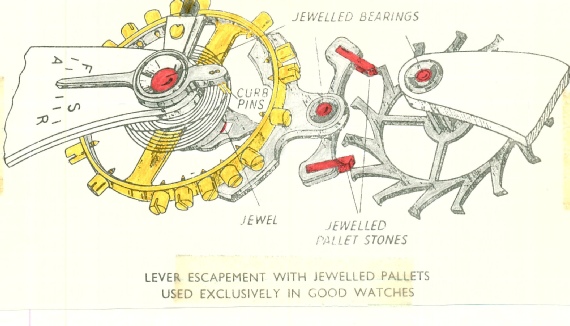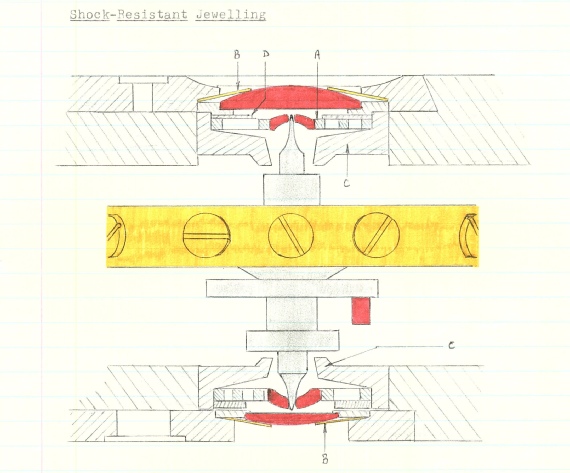|
The jewels in a watch are in various forms and perform various functions. There are cup-shaped jewels which take the pivots, there are the stones for the pallets, the ruby or impulse pin, endstones fitted to both ends of the balance staff, cap jewels to complete a shockproof system. Almost all of these jewels are made of synthetic ruby material like (fused aluminium oxide) produced specially for the purpose in rod form.The purpose of the bearing jewels of the train is to reduce wear and friction. Some authorities doubt whether jewelling is justified on the slower moving pivots of the train, a view of which I am not in agreement. Today, however it is common practice to jewel the train and a 15 jewelled lever is the basic norm. The 15 jewels mentioned above consists of:- two pallet stones, impulse pin on the roller, two jewel holes each for the three train wheels, two jewel holes for the pallet staff and two with end stones for the balance staff.The shape of the jewels is important, and their machining from rod form is a precise operation. The aim is a friction-free fit, but a fit without slop. The pinion must run without interference, but it must run parallel to the other wheels and pinions or wear will obviously result. For this reason also, the fitting of jewels into a plate is a skilled job.The endstones are caps to support the ends of the balance staff because the relatively heavy balance wheel makes the balance staff particularly susceptible to shock, they are therefore incorporated in a shock-absorbing device. A Jewelled Bearing. From the beginning horologists have been concerned with the problem of friction which not only acts as a brake on moving parts, but is the main cause of wear and consequent breakdown. The opposite is clearly, smooth working, hence a watchmaker has endeavoured all along to obtain in wheel and pinion cutting, in the bearings, the finish given to pivots, the type of oil which is used for the moving parts, the smooth working which is ideal. Before the invention of the jewelled bearing the pivots rotated in brass bearings, and steel pivots rotating in brass holes even though lubricated, set up friction, resulting in wear. But if a pivot makes its revolution within the smooth, hard surface of a polished stone or jewel a lot of frictional troubles are alleviated. Furthermore, the oil is retained within the jewel hole better than a brass hole. The Jewelled Lever Escapement The function of any escapement is to allow the motive power created by the mainspring to drain off, to escape, in regular amounts under precise control, the control being exercised by the oscillating balance wheel. It is this control, which is fairly consistent that helps the watch keep time. It is the recording, so to speak, of these, oscillations that is indicated by the watch hands moving over the watch dial. Shock-Resistant Jewelling In the Shockresist system (one of many systems, Incabloc, etc) the jewel-hole is set in a spring mount A. This is positioned vertically by washer D. The end-stone is retained by the spring washer B. These components are assembled in the housing C. While the jewels have a sideways movement and the end-stones are free to move vertically, it will be seen that movement in any direction will bring the special shoulders of the staff against C, protecting the pivots from shock and subsequent damage. |
|
|
||
|
|
|
|
|
|
||
|
|
||
|
|
|
|
|
|
||

